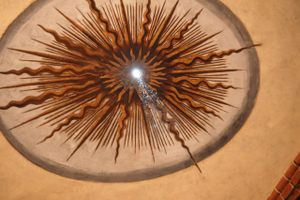
The Basilica di San Petronio at the center of Bologna may stand out at first glance because it is an impressively large Italian Gothic cathedral—the largest church in Bologna, in fact. But while the church's vaulted ceilings and richly decorated chapels may be noteworthy, what truly stands out is the massive sundial laid out on the floor.
This sundial was created by the astronomer Giovanni Domenico Cassini, whose most notable accomplishments included discovering four of Saturn’s moons and a gap within Saturn’s rings now known as the Cassini Division. While working at the University of Bologna, Cassini wanted to make more precise measurements of the motions of the Sun in the sky using a type of instrument called a meridian. This instrument consists of a hole in an elevated surface that projects the light from the Sun onto a line running from north to south. The exact elevation of the Sun can be determined by where its light is projected.
It was not the first sundial inside the Basilica di San Petronio. The church previously held a meridian line created by the 16th-century astronomer Egnazio Danti. It was used to measure the Sun’s position to aid in creating the Gregorian calendar. When the church proposed removing the older meridian line and replacing it with a smaller one, Cassini countered by proposing that he build a new one that was instead much larger. His proposal was accepted.
Cassini's new meridian line was constructed in 1655. It stretches for 67 meters (220 feet) through the left aisle from the middle of the church to a wall near the entrance. Because the meridian needed to be aligned precisely from north to south, the line is slightly angled relative to the aisle and just barely squeezes between two columns. A small hole in the fourth vault above the left aisle projects the Sun's image onto the meridian line below at approximately noon every day. The position of the Sun's image changes throughout the year, appearing closer to the north end of the church during winter and near the south side of the church during summer.
Using this meridian line, Cassini was able to measure the position and relative size of the Sun. With these measurements, he determined that the Earth’s orbit around the Sun was elliptical. Moreover, he even demonstrated that the Earth’s motion was faster when it was closer to the Sun and slower when it was further away, thus providing the first observational evidence for Kepler’s second law, one of three laws describing the orbits of objects in the Solar System.
Today, this meridian line is now more commonly referred to as the sundial in English, and it is a popular attraction within the church. Markings on the marble floor indicate the expected position of the Sun during different days and months of the year, with additional markings indicating the constellations that the Sun is passing through and the locations of the Sun during the equinoxes and solstices. The most popular time to visit is close to midday, when people will gather around to wait for the Sun’s image to appear.

Post a Comment